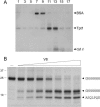Structure-function analysis of the yeast NAD+-dependent tRNA 2'-phosphotransferase Tpt1
- PMID: 15611301
- PMCID: PMC1370696
- DOI: 10.1261/rna.7193705
Structure-function analysis of the yeast NAD+-dependent tRNA 2'-phosphotransferase Tpt1
Abstract
Tpt1 is an essential 230-amino-acid enzyme that catalyzes the final step in yeast tRNA splicing: the transfer of the 2'-PO4 from the splice junction to NAD+ to form ADP-ribose 1''-2''cyclic phosphate and nicotinamide. To understand the structural requirements for Saccharomyces cerevisiae Tpt1 activity, we performed an alanine-scanning mutational analysis of 14 amino acids that are conserved in homologous proteins from fungi, metazoa, protozoa, bacteria, and archaea. We thereby identified four residues-Arg23, His24, Arg71, and Arg138-as essential for Tpt1 function in vivo. Structure-activity relationships at these positions were clarified by introducing conservative substitutions. The activity of the Escherichia coli ortholog KptA in complementing tpt1Delta was abolished by alanine substitutions at the equivalent side chains, Arg21, His22, Arg69, and Arg125. Deletion analysis of Tpt1 shows that the C-terminal 20 amino acids, which are not conserved, are not essential for activity in vivo at 30 degrees C. These findings attest to the structural and functional conservation of Tpt1-like 2'-phosphotransferases and identify likely constituents of the active site.
Figures



Similar articles
-
Analysis of 2'-phosphotransferase (Tpt1p) from Saccharomyces cerevisiae: evidence for a conserved two-step reaction mechanism.RNA. 2005 Jan;11(1):99-106. doi: 10.1261/rna.7194605. RNA. 2005. PMID: 15611300 Free PMC article.
-
Substrate recognition by a yeast 2'-phosphotransferase involved in tRNA splicing and by its Escherichia coli homolog.Biochemistry. 2001 Nov 20;40(46):14098-105. doi: 10.1021/bi011388t. Biochemistry. 2001. PMID: 11705403
-
NAD+-dependent synthesis of a 5'-phospho-ADP-ribosylated RNA/DNA cap by RNA 2'-phosphotransferase Tpt1.Nucleic Acids Res. 2018 Oct 12;46(18):9617-9624. doi: 10.1093/nar/gky792. Nucleic Acids Res. 2018. PMID: 30202863 Free PMC article.
-
The function of KptA/Tpt1 gene - a minor review.Funct Plant Biol. 2020 Jun;47(7):577-591. doi: 10.1071/FP19159. Funct Plant Biol. 2020. PMID: 32438974 Review.
-
Structure, regulation and function of phosphoinositide 3-kinases.Biochim Biophys Acta. 1994 Jul 18;1226(3):237-68. doi: 10.1016/0925-4439(94)90036-1. Biochim Biophys Acta. 1994. PMID: 8054357 Review. No abstract available.
Cited by
-
RNA damage in biological conflicts and the diversity of responding RNA repair systems.Nucleic Acids Res. 2016 Oct 14;44(18):8525-8555. doi: 10.1093/nar/gkw722. Epub 2016 Aug 17. Nucleic Acids Res. 2016. PMID: 27536007 Free PMC article. Review.
-
Structure of tRNA splicing enzyme Tpt1 illuminates the mechanism of RNA 2'-PO4 recognition and ADP-ribosylation.Nat Commun. 2019 Jan 15;10(1):218. doi: 10.1038/s41467-018-08211-9. Nat Commun. 2019. PMID: 30644400 Free PMC article.
-
NMR solution structures of Runella slithyformis RNA 2'-phosphotransferase Tpt1 provide insights into NAD+ binding and specificity.Nucleic Acids Res. 2021 Sep 27;49(17):9607-9624. doi: 10.1093/nar/gkab241. Nucleic Acids Res. 2021. PMID: 33880546 Free PMC article.
-
Multiple decay events target HAC1 mRNA during splicing to regulate the unfolded protein response.Elife. 2019 Mar 15;8:e42262. doi: 10.7554/eLife.42262. Elife. 2019. PMID: 30874502 Free PMC article.
-
Substrate analogs that trap the 2'-phospho-ADP-ribosylated RNA intermediate of the Tpt1 (tRNA 2'-phosphotransferase) reaction pathway.RNA. 2020 Apr;26(4):373-381. doi: 10.1261/rna.074377.119. Epub 2020 Jan 13. RNA. 2020. PMID: 31932322 Free PMC article.
References
-
- Abelson, J., Trotta, C.R., and Li, H. 1998. tRNA splicing. J. Biol. Chem. 273: 12685–12688. - PubMed
-
- Apostol, B.L., Westaway, S.K., Abelson, J., and Greer, C.L. 1991. Deletion analysis of a multifunctional yeast tRNA ligase polypeptide: Identification of essential and dispensable functional domains. J. Biol. Chem. 266: 7445–7455. - PubMed
-
- Avalos, J.L., Celic, I., Muhammad, S., Cosgrove, M.S., Boeke, J.D., and Wolberger, C. 2002. Structure of a Sir2 enzyme bound to an acetylated p53 peptide. Mol. Cell 10: 523–535. - PubMed
-
- Avalos, J.L., Boeke, J.D., and Wolberger, C. 2004. Structural basis for the mechanism and regulation of Sir2 enzymes. Mol. Cell 13: 639–648. - PubMed
-
- Bell, C.E. and Eisenberg, D. 1996. Crystal structure of diphtheria toxin bound to nicotinamide adenine dinucleotide. Biochemistry 35: 1137–1149. - PubMed
MeSH terms
Substances
LinkOut - more resources
Full Text Sources
Molecular Biology Databases
